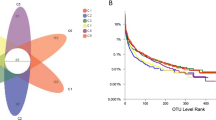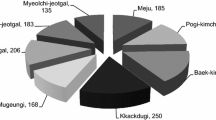Abstract
Bacterial populations in fermented grains during fermentation may play important roles in Chinese liquor flavor. PCR-based denaturing gradient gel electrophoresis (DGGE) and 16S rRNA gene library analysis were performed to analyze the bacterial community structure of two styles of liquor. The results of DGGE profiles showed that bacterial diversity decreased with the fermentation process and Lactobacillus acetotolerans became the predominant species at the end of the fermentation. But the obvious differences of bacterial community appeared in the middle stage of two styles of liquor fermentation, in which the different upstream production techniques were used. Moreover, 16S rRNA gene libraries of two styles were constructed. A total of 125 and 107 clones, chosen from two libraries, were grouped into 46 and 49 operational taxonomic units (OTUs) by amplified ribosomal DNA restriction analysis. According to sequencing results of clones, the predominant bacteria in strong aroma style fermented grains were those from the class Bacilli, Bacteroidetes, and Clostridia, whereas the predominant bacteria in fermented grains of roasted sesame aroma style belonged to Bacilli, Flavobacteria, and Gammaproteobacteria. Molecular analysis of the bacterial diversity of the liquor fermentation will benefit the analysis of important microorganisms playing key roles in the formation of liquor flavor components.






Similar content being viewed by others
References
Amann R, Ludwig W, Schleifer KH (1995) Phylogenetic identification and situ detection of individual microbial cells without cultivation. Microbiol Rev 58:143–169
Bowers HA, Tengs T, Glasgow HB, Burkholder JJM, Rublee PA, Oldach DW (2000) Development of real-time PCR assays for rapid detection of Pfiesteria piscicida and related dinoflagellates. Appl Environ Microbiol 66(11):4641–4648
di Giovanni GD, Watrud LS, Seidler RJ, Widmer F (1999) Fingerprinting of mixed bacterial strains and BIOLOG gram-negative (GN) substrate communities by enterobacterial repetitive intergenic consensus sequence-PCR (ERIC-PCR). Curr Microbiol 38:217–223
Dunbar J, White S, Forney L (1997) Genetic diversity through the looking glass: effect of enrichment bias. Appl Environ Microbiol 63:1326–1331
Fan WL, Qian MC (2006) Characterization of aroma compounds of Chinese “Wuliangye” and “Jiannanchun” liquors by aroma extract dilution analysis. J Agric Food Chem 54:2695–2704
Giovannoni SJ, Britschgi TB, Moyer CL, Field KG (1990) Genetic diversity in sargasso sea bacterioplankton. Nature 345:60–62
Kemp PF, Aller JY (2004) Estimating prokaryotic diversity: when are 16S rDNA libraries large enough? Limnol Oceanogr Methods 2:114–125
Liao JM, Yao WC, Tang YM, Ren DQ (2001) Preliminary identification of microbes in liquor Qu of strong aroma style. Liquor Mak 28(5):42–43
Luo ZT (1986) Preliminary research on microbes in Zaopei. Microbiology (2):59–60
Muyzer G (1999) DGGE/TGGE a method for identifying genes from natural ecosystems. Curr Opin Microbiol 2:317–322
Muyzer G, de Waal EC, Uitterlinden AG (1993) Profiling of complex microbial populations by denaturing gradient gel electrophoresis analysis of polymerase chain reaction-amplified genes coding for 16S rRNA. Appl Environ Microbiol 59(3):695–700
Muyzer G, Smalla K (1998) Application of denaturing gradient gel electrophoresis (DGGE) and temperature gradient gel electrophoresis (TGGE) in microbial ecology. Antonie van Leeuwenhoek 73:127–141
Reysenbach AL, Pace NR (1995) Reliable amplification of hyperthermophilic archaeal 16S rRNA genes by the polymerase chain reaction. In: Robb FT, Place AR, Sowers KR, Schreier HJ, DasSarma S, Fleischmann EM (eds) Archaea––a laboratory manual: thermophiles. Cold Spring Harbor Laboratory Press, Cold Spring Harbor, pp 101–106
Sambrook J, Fritsch EF, Maniatis T (1999) Molecular cloning: a laboratory manual. Science Press, Beijing
Shi AH (1986) Analysis on microorganisms in liquor pit of strong aroma style during fermentation. Liquor Mak (4):24–29
Shi AH, Guan JK, Zhang WP, Xu ER, Xu CX (2001) Analysis of microbial species in Xufang Daqu and determination of the dominant microbes. Liquor Mak Sci Technol 108(6):26–28
Vaneechoutte M, Rossau R, Vos PD, Gillis M, Janssens D, Paepe N, Rouck AD, Fiers T, Claeys G, Kersters K (1992) Rapid identification of bacteria of the comamonadaceae with amplified ribosomal DNA-restriction analysis (ARDRA). FEMS Microbiol Lett 93:227–234
Wang RM, Guan FM, Lu FY (2001) Research on functional microbial product of activity pit clay. Liquor Mak 28(1):33–35
Ward DM, Weller R, Bateson MM (1990) 16S rRNA sequences reveal numerous uncultured microorganisms in a natural community. Nature 345:63–65
Xiong CX (1994) Research on changes of microbes and materials in Zaopei during fermentation of strong aroma style liquor. Liquor Mak Sci Technol (2):25
Zhang XL, Yan X, Gao PP, Wang LH, Zhou ZH, Zhao LP (2005) Optimized sequence retrieval from single bands of TGGE (temperature gradient gel electrophoresis) profiles of the amplified 16S rDNA fragments from an activated sludge system. J Microbiol Methods 60(1):1–11
Zhang WX, Qiao ZW, Shigematsu T, Tang YQ, Hu C, Morimura S, Kida K (2005) Analysis of the bacterial community in Zaopei during production of Chinese Luzhou-flavor liquor. J Inst Brew 111(2):215–222
Acknowledgments
This research was financially supported by the program for Changjiang Scholars and Innovative Research Team in University (IRT0532) and National Key Technology R&D Program (2007BAK36B02).
Author information
Authors and Affiliations
Corresponding author
Rights and permissions
About this article
Cite this article
Wang, HY., Zhang, XJ., Zhao, LP. et al. Analysis and comparison of the bacterial community in fermented grains during the fermentation for two different styles of Chinese liquor. J Ind Microbiol Biotechnol 35, 603–609 (2008). https://doi.org/10.1007/s10295-008-0323-z
Received:
Accepted:
Published:
Issue Date:
DOI: https://doi.org/10.1007/s10295-008-0323-z




